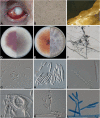Keratitis by Fusarium temperatum, a novel opportunist
- PMID: 25388601
- PMCID: PMC4234859
- DOI: 10.1186/s12879-014-0588-y
Keratitis by Fusarium temperatum, a novel opportunist
Abstract
Background: Fusarium species are among the most common fungi present in the environment and some species have emerged as major opportunistic fungal infection in human. However, in immunocompromised hosts they can be virulent pathogens and can cause death. The pathogenesis of this infection relies on three factors: colonization, tissue damage, and immunosuppression. A novel Fusarium species is reported for the first time from keratitis in an agriculture worker who acquired the infection from plant material of maize. Maize plants are the natural host of this fungus where it causes stalk rot and seeding malformation under temperate and humid climatic conditions. The clinical manifestation, microbiological morphology, physiological features and molecular data are described.
Methods: Diagnosis was established by using polymerase chain reaction of fungal DNA followed by sequencing portions of translation elongation factor 1 alpha (TEF1 α) and beta-tubulin (BT2) genes. Susceptibility profiles of this fungus were evaluated using CLSI broth microdilution method.
Results: The analyses of these two genes sequences support a novel opportunist with the designation Fusarium temperatum. Phylogenetic analyses showed that the reported clinical isolate was nested within the Fusarium fujikuroi species complex. Antifungal susceptibility testing demonstrated that the fungus had low MICs of micafungin (0.031 μg/ml), posaconazole (0.25 μg/ml) and amphotericin B (0.5 μg/ml).
Conclusion: The present case extends the significance of the genus Fusarium as agents of keratitis and underscores the utility of molecular verification of these emerging fungi in the human host.
Figures



References
-
- Ibrahim MM, Vanini R, Ibrahim FM, Fioriti LS, Furlan EM, Provinzano LM, De Castro RS, de Faria E, Sousa SJ, Melani Rocha E. Epidemiologic aspects and clinical outcome of fungal keratitis in southeastern Brazil. Eur J Ophthalmol. 2009;19:355–361. - PubMed
Publication types
MeSH terms
Substances
Associated data
- Actions
- Actions
LinkOut - more resources
Full Text Sources
Other Literature Sources
Medical

